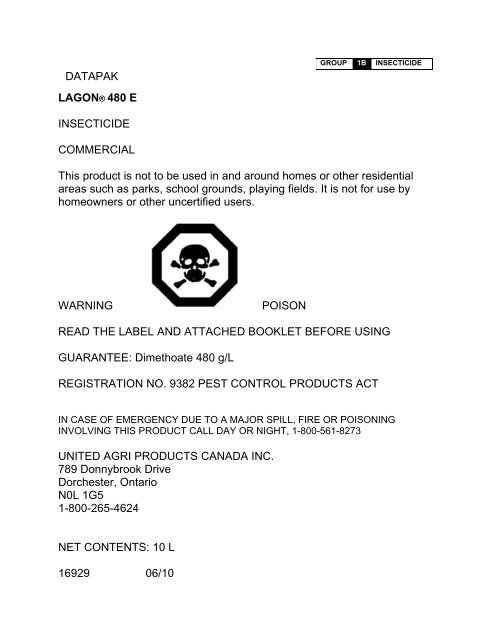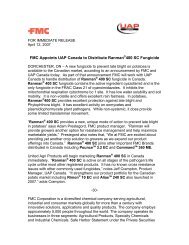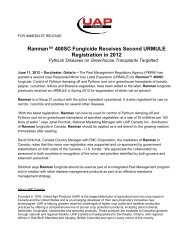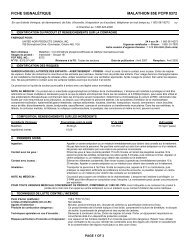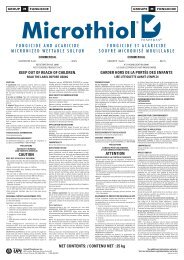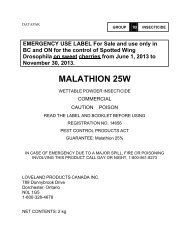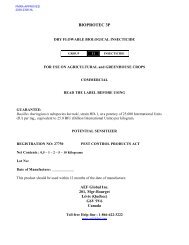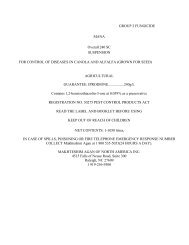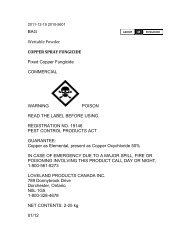1 DATAPAK LAGON® 480 E INSECTICIDE COMMERCIAL ... - UAP
1 DATAPAK LAGON® 480 E INSECTICIDE COMMERCIAL ... - UAP
1 DATAPAK LAGON® 480 E INSECTICIDE COMMERCIAL ... - UAP
Create successful ePaper yourself
Turn your PDF publications into a flip-book with our unique Google optimized e-Paper software.
1 <strong>DATAPAK</strong><br />
B<br />
LAGON® <strong>480</strong> E<br />
GROUP 1B <strong>INSECTICIDE</strong><br />
<strong>INSECTICIDE</strong><br />
<strong>COMMERCIAL</strong><br />
This product is not to be used in and around homes or other residential<br />
areas such as parks, school grounds, playing fields. It is not for use by<br />
homeowners or other uncertified users.<br />
WARNING<br />
POISON<br />
READ THE LABEL AND ATTACHED BOOKLET BEFORE USING<br />
GUARANTEE: Dimethoate <strong>480</strong> g/L<br />
REGISTRATION NO. 9382 PEST CONTROL PRODUCTS ACT<br />
IN CASE OF EMERGENCY DUE TO A MAJOR SPILL, FIRE OR POISONING<br />
INVOLVING THIS PRODUCT CALL DAY OR NIGHT, 1-800-561-8273<br />
UNITED AGRI PRODUCTS CANADA INC.<br />
789 Donnybrook Drive<br />
Dorchester, Ontario<br />
N0L 1G5<br />
1-800-265-4624<br />
NET CONTENTS: 10 L<br />
16929 06/10
PRECAUTIONS<br />
HARMFUL OR FATAL IF SWALLOWED, INHALED OR ABSORBED THROUGH THE SKIN<br />
KEEP OUT OF REACH OF CHILDREN<br />
Avoid breathing vapour or spray mist. Use only with adequate ventilation. Do not use indoors. Avoid prolonged or repeated contact<br />
with skin. Wash thoroughly after handling and before eating and smoking. Avoid contamination of feed and food stuffs. Keep away<br />
from heat, sparks and open flame.<br />
Do not use in milk processing or storage rooms. Remove livestock and poultry from buildings when spraying. Do not contaminate<br />
feed troughs, litter or drinking fountains. Do not use indoors. Do not mix with whitewash or apply within 2 weeks of whitewashing.<br />
Keep out of sun.<br />
When spraying honey-producing crops (alfalfa, red clover, sweet clover and alsike) spray at least 5 days before bloom appears and<br />
do not introduce hives until full bloom. Hives should be removed from vicinity before making spray applications. If spraying must be<br />
done during the blooming period, restrict application to the period after dark or very early morning in order to reduce mortality to<br />
bees that may be visiting the blooms.<br />
This product is toxic to birds and wildlife. To reduce injury to bees, restrict application to the period after dark when bees are inside<br />
the hives or in the early morning before the bees are foraging in the fields. Do not apply to such crops as alfalfa when in full bloom.<br />
This product contains a petroleum distillate which is moderately to highly toxic to aquatic organisms. Avoid contamination of aquatic<br />
systems during application. Do not contaminate these systems through direct application, disposal of waste or cleaning equipment.<br />
Ship and store between 4° and 30° C.<br />
If this pest control product is to be used on a commodity that may be exported to the U.S. and you require information on acceptable<br />
residue levels in the U.S., visit CropLife Canada’s website at: www.croplife.ca.<br />
DIRECTIONS FOR USE<br />
LAGON <strong>480</strong> E Insecticide is generally effective in controlling aphids, and other listed insects, scales and mites.<br />
LAGON <strong>480</strong> E Insecticide may be applied by spray or soil drench. LAGON <strong>480</strong> E Insecticide is an emulsifiable concentrate. Use<br />
designated amounts in full volume of water.<br />
RESISTANCE MANAGEMENT RECOMMENDATIONS<br />
For resistance management, please note that LAGON <strong>480</strong> E Insecticide contains a Group 1B insecticide/acaricide. Any insect/mite<br />
population may contain individuals naturally resistant to LAGON <strong>480</strong> E Insecticide and other Group 1B insecticide/acaricide. The<br />
resistant individuals may dominate the insect/mite population if this group of insecticides/acaricides are used repeatedly in the same<br />
fields. Other resistance mechanisms that are not linked to site of action but are specific for individual chemicals, such as enhanced<br />
metabolism, may also exist. Appropriate resistance-management strategies should be followed.<br />
To delay insecticide/acaricide resistance:<br />
• Where possible, rotate the use of LAGON <strong>480</strong> E Insecticide or other Group 1B insecticides/acaricides with different groups<br />
that control the same pathogens.<br />
• Avoid application of more than the indicated number of sprays of LAGON <strong>480</strong> E Insecticide or other insecticides/acaricides<br />
in the same group in a season.<br />
• Use tank mixtures with insecticides/acaricides from a different group when such use is permitted.<br />
• Insecticide/acaricide use should be based on an IPM program that includes scouting, record keeping and considers cultural,<br />
biological and other chemical control practices.<br />
• Monitor treated pest populations for resistance development.<br />
• Contact your local extension specialist or certified crop advisors for any additional pesticide resistance-management and/or<br />
IPM recommendations for the specific site and pest problems in your area.<br />
• For further information and to report suspected resistance, contact the Technical Service, United Agri Products, 1-800-265-<br />
4624 or at www.uap.ca.<br />
FOR GROUND APPLICATION: dilute with water to 200 - 300 L/ha unless otherwise stated.<br />
FOR AERIAL APPLICATION: unless otherwise stated, dilute with water to 11 - 22 L/ha for blueberries, cereals (barley, oats, wheat,<br />
rye) and peas. Dilute with water to 10-30 L/ha for other field and vegetable crops when aerial application is specified.<br />
AERIAL APPLICATION INSTRUCTIONS<br />
Use only where aerial application is indicated on this label.<br />
Apply only by fixed-wing or rotary aircraft equipment which has been functionally and operationally calibrated for the atmospheric<br />
conditions of the area and the application rates and conditions of this label.<br />
Label rates, conditions and precautions are product specific. Read and understand the entire label before opening this product.<br />
Apply only at the rate recommended for aerial application on this label. Where no rate for aerial application appears for the specific<br />
use, this product cannot be applied by any type of aerial equipment.<br />
Ensure uniform application. To avoid streaked, uneven or overlapped application, use appropriate marking devices.
Apply only under conditions of good practice specific to aerial application as outlined in the National Aerial Pesticide Application<br />
Manual, developed by the Federal/Provincial/Territorial Committee on Pest Management and Pesticides.<br />
Use Precautions<br />
Apply only when meteorological conditions at the treatment site allow for complete and even crop coverage.<br />
Do not apply to any body of water. Avoid drifting of spray onto any body of water or other non-target areas.<br />
Coarse sprays are less likely to drift, therefore, avoid combinations of pressure and nozzle type that will result in fine particles (mist).<br />
Use low nozzle pressure (Below 300 kPa). Do not apply during periods of dead calm or when wind velocity and direction pose a risk<br />
of spray drift. Do not spray in winds exceeding 10 - 15 km per hour. Do not spray when the wind is blowing towards a nearby<br />
sensitive crop, garden, terrestrial habitat (such as shelter-belt) or aquatic habitat. Do not allow spray drift onto sensitive areas such<br />
as water, urban and residential areas.<br />
Operator Precautions<br />
Do not allow the pilot to mix chemicals to be loaded onto the aircraft. Loading of premixed chemicals with a closed system is<br />
permitted.<br />
It is desirable that the pilot have communication capabilities at each treatment site at the time of application.<br />
The field crew and the mixer/loaders must wear chemical resistant gloves, coveralls and goggles or face shield during<br />
mixing/loading, cleanup and repair. Follow the more stringent label precautions in cases where the operator precautions exceed the<br />
label recommendations on the existing ground boom label.<br />
All personnel on the job site must wash hands and face thoroughly before eating and drinking. Protective clothing, aircraft cockpit<br />
and vehicle cabs must be decontaminated regularly.<br />
Product Specific Precautions<br />
If you have questions, call the manufacturer at 1-800-265-4624 or obtain technical advice from the distributor or your provincial<br />
agricultural representative. Application of this specific product must meet and/or conform to the following:<br />
Volume: Apply the recommended rate in a minimum spray volume of 10 litres per hectare unless otherwise stated.<br />
HOUSEFLY CONTROL<br />
(for up to 6 weeks) Residual Wall Sprays:<br />
For the control of houseflies in dairy barns, hog pens, calf barns, poultry houses and other farm buildings apply a residual spray to<br />
the ceilings, walls, stanchions. Remove livestock and poultry from buildings before spraying. Prepare the spray by mixing 250 mL of<br />
LAGON <strong>480</strong> E Insecticide in 10 L of water. Thoroughly wet all fly-resting areas to the point of run-off. Use 5-6 L of spray to cover<br />
100 m2 of surface. Repeat application when necessary. Good sanitation is an essential part of any effective fly control program. Do<br />
not use in homes.<br />
Spot Sprays: For localized housefly control in farm buildings, apply a spray containing 200-250 mL of LAGON <strong>480</strong> E Insecticide in<br />
10 L of water. Apply with a knapsack sprayer to doorways, counters and other areas frequented by flies.<br />
General Outdoor Use: To control houseflies around homes, recreation areas, garbage cans, animal quarters, food processing<br />
plants, warehouses, loading docks and refuse areas, spray exposed surfaces such as walls, fences, refuse containers and garbage,<br />
with 1% LAGON <strong>480</strong> E Insecticide solution. Repeat application should be made when necessary. Exposure of sprayed areas to<br />
weather, particularly sunshine reduces the duration of residual effects.<br />
FIELD AND VEGETABLE CROPS:<br />
Sprays should be applied when the pests first appear and repeated as the infestation warrants, or as otherwise directed.<br />
Applications should be made in sufficient water to obtain good coverage. When aerial application is specified apply with aerial<br />
equipment and use 10 to 30L of water per hectare. Applications may be made by ground equipment unless otherwise specified.<br />
PESTS AMOUNT AMOUNT PREHARVEST MAXIMUM # OF<br />
FIELD AND CONTROLLED PER PER INTERVALS APPLICATIONS<br />
VEGETABLE CROPS HECTARE 10 LITRES (DAYS) PER SEASON<br />
Alfalfa Aphids,Leafhoppers 425 mL 4 mL 2 2<br />
(for seed and<br />
reduction of<br />
forage production)<br />
alfalfa weevil larvae<br />
COMMENTS: Do not graze or harvest for forage within 2 days after application.<br />
Blotch leafminers 550 mL 5 mL 2 1<br />
COMMENTS: Use a water volume of at least 200 L/ha with ground equipment for Blotch leafminers.<br />
Do not apply during bloom. May be applied by Ground and Aerial application.<br />
Grasshoppers 550 mL 5 mL 2 1<br />
- nymphs<br />
Grasshoppers 850 - 900 mL 9 mL 7 2<br />
-adults or winged
COMMENTS: Follow provincial forecast. Apply when insects are present as young hoppers or signs<br />
of insect damage are evident. Apply when the grasshoppers are in the 2-4 nymphal stage. Best<br />
control will be achieved when application is made prior to wing development. Under severe insect<br />
pressure application should also be made to a 15 metre strip along fence rows around the field. DO<br />
NOT APPLY TO ADJACENT UNREGISTERED CROPS. The higher rate should be used when the<br />
proportion of mature and late nymphal stages in the population are high and spray penetration is<br />
inhibited by dense crop canopy.<br />
Alfalfa Lygus bugs 1.1 L 10 mL 28 1<br />
(seed production)<br />
Plant bugs<br />
COMMENTS: Apply just before alfalfa begins to bloom. Allow at least 10 days before placing leaf<br />
cutting bees in the field. Do not graze or harvest for forage with 28 days after treatment. May be<br />
applied by Ground and Aerial application.<br />
Asparagus Asparagus aphid 2.3 L 35 mL Not Applicable 6<br />
COMMENTS: Ground Application: Apply by boom or field sprayer using 675 L of water/ha. For<br />
mature asparagus, sprays should begin July 1, after crop has been harvested, and continue at 3-4<br />
week intervals until defoliation in October. For immature asparagus, begin application mid-May.<br />
Ground application ONLY.<br />
Barley, Oats, Wheat Thrips 1 L 10 mL 7 2<br />
(ALSO SEE<br />
CEREALS below) COMMENTS: Ground Application: Use sufficient water to obtain good coverage (usually 110 – 275<br />
L/ha). Same limitations apply for harvesting and grazing as in wheat section of this label. Ground and<br />
Aerial application. With aerial equipment use 10 to 30 L of water per hectare.<br />
Beans (Pole, Snap) Aphids 700 mL - 1 L 7 - 10 mL 7 3<br />
Grasshoppers<br />
Leafhoppers<br />
Leafminers<br />
Mexican bean beetles<br />
Mites, Lygus bugs<br />
Tarnished plant bugs<br />
COMMENTS: Use sufficient water for good coverage. Repeat applications as necessary. Do not feed<br />
or graze treated foliage to livestock. May be applied by Ground and Aerial application.<br />
Beets Tarnished plant bugs 700 mL 7 mL 12 3<br />
COMMENTS: Ground application ONLY.<br />
Cauliflower Aphids 700 mL - 1 L 7 - 10 mL 4 3<br />
Broccoli<br />
Broccoli<br />
Brussels Sprouts<br />
Cauliflower<br />
21<br />
Brussels Sprouts<br />
COMMENTS: Use sufficient water for good coverage. Repeat applications as necessary. Ground<br />
Application ONLY.<br />
Cauliflower Thrips 550 mL - 1.25 L 6 - 12 mL 4 3<br />
Broccoli<br />
Apply at 10 day intervals starting at head formation. Ground Application ONLY.<br />
Canary Grass Aphids 500 mL 5 mL 21 2<br />
(Grown for seed)<br />
COMMENTS: Apply in aerial or ground application when there are more than 50 aphids per canary<br />
seed head between heading and soft dough stage. May be applied by Ground and Aerial application.<br />
Canola (rape) Aphids 850 - 900 mL 9 mL 21 3<br />
Leafhoppers<br />
Grasshoppers<br />
COMMENTS: May be applied by ground and aerial application.<br />
Celery Aphids-including 700 mL 7 mL 3 3<br />
carrot<br />
green peach<br />
foxglove aphids
COMMENTS: Begin application 3 weeks after transplanting. Ground application ONLY.<br />
Cereals (barley, Grasshoppers 550 mL 5 mL 2 2<br />
oats, wheat, rye)<br />
-nymphs,<br />
Say stink bugs<br />
Grasshoppers 850 mL - 1 L See comments 2<br />
-adults<br />
COMMENTS: Do not graze or harvest for forage within 7 days after treatment at the 850 mL rate. Do<br />
not graze or harvest for forage within 28 days after treatment at the 1 L rate. Follow provincial<br />
forecast. Apply when the grasshoppers are in the 2-4 nymphal stage. Best control will be achieved<br />
when application is made prior to wing development. Under severe insect pressure application should<br />
also be made to a 15 metre strip along fence rows around the field. DO NOT APPLY TO ADJACENT<br />
UNREGISTERED CROPS. The higher rate should be used when the proportion of mature and late<br />
nymphal stages in the population are high and spray penetration is inhibited by dense crop canopy.<br />
May be applied by Ground and Aerial application.<br />
Chicory, Aphids 600 mL - 1 L 6 - 10 mL 7 3<br />
Chinese Broccoli<br />
Bok Choi<br />
COMMENTS: Apply in sufficient water for thorough coverage. Use ground application to foliage. Apply<br />
when aphids are present. Ground application ONLY.<br />
Eggplant Tarnished plant bug 500 - 700 mL 5-7 mL 7 2<br />
COMMENTS: Apply when bugs are found and flowering is seen. Treat again in 7-10 days if bugs are<br />
found. Consult local authorities for proper timing. Do not apply when bees are foraging. Ground<br />
application ONLY.<br />
Flax Potato Aphid 437 mL 4 mL 21 1<br />
COMMENTS: Apply from late flowering to early green bole stage; in sufficient water to provide good<br />
coverage. May be applied by either ground or aerial methods. Use in 200 L/ha of water for ground<br />
and 11 - 22 L of water/ha for aerial equipment.<br />
Forage crops Aphids 425 - 550 mL 4 - 5 mL 2 2<br />
(grasses, alfalfa,<br />
(Only suppression of Russian Wheat aphid is provided)<br />
hay, clover)<br />
Grasshopperslow<br />
infestations 425 – 550 mL 2 2<br />
nymphs 550 mL 2 2<br />
adults 850 mL – 1L 28 2<br />
Lygus Bug 425 mL 2 2<br />
Plant Bug 425 mL 2 2<br />
COMMENTS: Do not graze or harvest for forage within 2 days after treatment at the 425 or 550 mL<br />
rate. Do not graze or harvest for forage within 28 days after treatment at the 850 mL – 1 L rate. May<br />
be applied by either ground or aerial methods.<br />
Leafy Vegetables: Aphids 700 mL 7 mL (See Below) 2<br />
Lettuce, Swiss<br />
Leafhoppers<br />
chard, Kale,<br />
Beet greens and<br />
COMMENTS: Ground application ONLY. Use sufficient water for good coverage. Do not use on Head<br />
Turnip greens<br />
Lettuce. Interval between last application and harvest:<br />
Lettuce 7 days Beet greens 21 days<br />
Swiss chard 7 days Turnip greens 7 days<br />
Kale<br />
7 days<br />
Peas Aphids 275 - 425 mL 2.5 - 4 mL 3 2<br />
(canning & field)<br />
COMMENTS: Apply by aircraft or by ground equipment. Use sufficient water for good coverage.<br />
Repeat application as necessary. Do not feed or graze for forage within 21 days after last application.<br />
Dilute for ground (100-300 L of water/ha) and aerial application (10-30 L of water/ha).<br />
Peppers Aphids, Maggots 700 mL - 1L 7 - 10 mL 3 3<br />
COMMENTS: Use sufficient water for good coverage. Repeat application as necessary. Ground<br />
application ONLY.
Potatoes, Tomatoes Aphids 550 mL - 1.1 L 5 - 10 mL 7 3<br />
(field)<br />
Leafhoppers<br />
Tarnished plant bugs<br />
COMMENTS: Use sufficient water for good coverage. Do not apply more than 3 applications per<br />
season. Consult local agricultural authorities for proper timing. Ground application ONLY.<br />
Pastures<br />
Grasshoppers<br />
Wastelands -nymphs 550 mL 2 2<br />
-adults 850 mL-1 L See Comments<br />
COMMENTS: Follow provincial forecast. Apply when insects are present as young hoppers or signs<br />
of insect damage are evident. Apply when the grasshoppers are in the 2-4 nymphal stage. Best<br />
control will be achieved when application is made prior to wing development. Under severe insect<br />
pressure application should also be made to a 15 metre strip along fence rows around the field.<br />
DO NOT APPLY TO ADJACENT UNREGISTERED CROPS. The higher rate should be used when<br />
the proportion of mature and late nymphal stages in the population are high and spray penetration is<br />
inhibited by dense crop canopy. Use high rate for adult grasshopper control on wasteland. Remove<br />
cattle before spraying. Do not graze or harvest for forage within 2 days after treatment at the 550 mL<br />
rate. Do not graze or harvest for forage within 7 days after treatment at the 850 mL rate. Do not graze<br />
or harvest for forage within 28 days at the 1L rate. May be applied by ground and aerial application.<br />
Safflower Grasshoppers 550 mL-1L 21 2<br />
(nymphs and adults)<br />
COMMENTS: Apply when damage is apparent and more than 15 grasshoppers per square meter are<br />
found in the crop. Repeat the application only when necessary. Use sufficient water for good<br />
coverage. May be applied by ground and aerial application.<br />
Soybeans Aphids 0.7-1 L 7-10 mL 30 3<br />
bean beetles<br />
leafhoppers<br />
tarnished plant<br />
bugs, lygus bugs<br />
COMMENTS: Use sufficient water for good coverage. Repeat applications as necessary. Do not<br />
exceed 3 applications per season. Do not feed or graze treated foliage to livestock. May be applied<br />
by Ground and Aerial application.<br />
Spider mites 1 L 10 mL 30 2<br />
(Two-spotted)<br />
COMMENTS: Apply by ground application in sufficient water for thorough coverage. Do not feed or<br />
allow livestock to graze treated forage. May be applied by ground and aerial application.<br />
Sweet Clover Sweet clover weevil 850 mL - 1.1 L 28 2<br />
Red Clover<br />
Alsike Clover<br />
COMMENTS: Do not graze or harvest for forage within 28 days after treatment. May be applied by<br />
ground and aerial application.<br />
Wheat Orange wheat, 1 L 21 2<br />
(ALSO SEE<br />
blossom midge,<br />
CEREALS above)<br />
Russian wheat<br />
aphid<br />
COMMENTS: If midge population persists at 3 - 7 days apply a second treatment. Use a water<br />
volume of at least 100 L/ha with ground equipment and 50 L/ha by air. Higher volume will provide<br />
more thorough coverage. If adult midges are present (1 midge/4-5 wheat heads), sprays should be<br />
applied when 25% of the wheat head has fully emerged from the boot but before flowering has<br />
begun. At this stage, wheat first becomes susceptible to attack by egg-laying females. Applications<br />
should be made in the late afternoon or evening when temperatures exceed 15°C and the wind speed<br />
is less than 10 km/h. Higher volume sprays will improve penetration of the crop. Proper timing of<br />
application is essential for control. Do not harvest within 21 days of the application. Do not apply to<br />
areas where bees are actively foraging or near apiaries as product is toxic to bees. Do not graze or<br />
use for forage within 7 days of application. Consult provincial authorities for further information<br />
concerning rates and time of application.
FRUIT CROPS:<br />
APPLY WITH GROUND EQUIPMENT ONLY UNLESS OTHERWISE NOTED. FOR DILUTE GROUND APPLICATIONS, USE<br />
DESIGNATED AMOUNT OF LAGON <strong>480</strong>E IN 1000 LITRES OF WATER UNLESS OTHERWISE SPECIFIED. For Cherry, Peach<br />
and Pear, the rate per hectare is based on using 3000 L of spray on full sized trees, 4.5-5.5 metres high. Trees smaller or larger<br />
may require more or less LAGON <strong>480</strong> E. Follow provincial calendar guidelines as to water volumes for the size of tree being<br />
sprayed.<br />
PESTS AMOUNT AMOUNT PREHARVEST MAXIMUM # OF<br />
CONTROLLED PER PER INTERVALS APPLICATIONS<br />
FRUIT TREE CROPS 1000L 10 LITRES (DAYS) PER SEASON<br />
Pears Tarnished plant 625 mL 6 mL 14 2<br />
bugs<br />
COMMENTS: Pears: Apply at pre-bloom.<br />
Pear Psylla 1 - 1.25 L 10 - 12.5 mL 14 2<br />
COMMENTS: Use sufficient water for good cover spray.<br />
Aphids 1 - 1.25 L 10 - 12.5 mL 14 2<br />
COMMENTS: Use sufficient water for good cover spray.<br />
Mites 1 - 1.25 L 10 - 12.5 mL 14 2<br />
COMMENTS: Use sufficient water for good cover spray.<br />
Peaches Aphids, Mites 1 - 1.5 L 10 - 15 mL - 2<br />
(non-bearing)<br />
Tarnished plant 500 mL 5 mL - 2<br />
bugs<br />
COMMENTS: Spray when insects first appear and repeat as necessary using sufficient water for<br />
good coverage. Some defoliation may occur under cold wet soil and/or slow drying conditions during<br />
and following application. Least injury has occurred when sprays were applied in the morning while<br />
temperatures are moderate and drying conditions are fairly good.<br />
Sour Cherries Cherry fruit fly 500 mL 5 mL 21 2<br />
maggots<br />
COMMENTS: Apply no later than 6 days after the first adult fly has been trapped and repeat in 14<br />
days if required.<br />
Sweet Cherries Cherry fruit fly 500 mL 5 mL 21 2<br />
maggots<br />
COMMENTS: Apply no later than 6 days after the first adult fly has been trapped and repeat in 14<br />
days if required.<br />
PESTS AMOUNT AMOUNT PREHARVEST MAXIMUM # OF<br />
CONTROLLED PER PER INTERVALS APPLICATIONS<br />
SMALL FRUIT CROPS HECTARE 10 LITRES (DAYS) PER SEASON<br />
Blueberry Blueberry maggot 600 - 825 mL 6 - 8 mL 15 2<br />
(Lowbush &<br />
Highbush)<br />
COMMENTS: Apply pesticide in sufficient water for good coverage, one week after first berries ripen.<br />
Use no more than 1000 L spray/ha. Make 1 or 2 applications between mid to late July. May vary<br />
depending on area and season. May be applied with ground equipment or aerial equipment.<br />
Strawberries Tarnished plant 1.25 L 12.5 mL 7 2<br />
(bearing)<br />
bug<br />
COMMENTS: Apply first spray when first blooms appear and the second application 10-12 days later<br />
if needed.
Strawberries Aphids, mites 1 L/ha 10 mL 7 3<br />
(bearing &<br />
non-bearing)<br />
COMMENTS:Use sufficient water for good cover spray. Apply when insects first appear and repeat at<br />
monthly intervals as required.<br />
CROPS PEST RATE PER HECTARE REMARKS<br />
Filberts, Hazelnuts Aphids 5L Use one application per season. Apply when<br />
aphids appear. DO NOT USE WITHIN 45 DAYS<br />
OF HARVEST. Primarily for use on young<br />
plantings.<br />
ORNAMENTALS<br />
GENERAL COMMENTS ORNAMENTAL PLANTS<br />
APPLY ONLY WITH GROUND APPLICATION EQUIPMENT<br />
1. LAGON <strong>480</strong> E is a true systemic insecticide. A systemic insecticide is absorbed into the system of the plant upon<br />
application, and as with all systemic materials, may cause reactions in specific plants which are not predictable nor common<br />
to all members of the species. Do not over-dose or over-spray.<br />
2. FOR PROPER TIMING of treatments for the control of specific pests on ornamental plants, consult local agricultural<br />
authorities. In general, apply adequate spray for good coverage when pests appear or when damage is first observed,<br />
unless otherwise indicated.<br />
3. EXPERIENCE has shown when dealing with species that may be injured by foliar application, soil drenches are safer on<br />
those plants for which they are recommended. When using foliar sprays, do not apply during heat of the day or when<br />
temperatures are excessively high.<br />
4. DO NOT USE on ornamental plants not listed.<br />
5. WHEN IN DOUBT about plant safety, it is advisable to spray a single branch or dip several leaves in the spray solution. A<br />
waiting period of 3 or 4 days will usually indicate if plant damage will result.<br />
6. DO NOT SPRAY the following species unless you have tested single branches or leaves to ascertain safety:<br />
American Elm<br />
Mop-head Elm<br />
Norway Maple<br />
Mock Orange<br />
Sunburst Locust<br />
Morraine Locust<br />
or other ornamentals not listed in this pamphlet.<br />
7. There has been no report of damage by LAGON <strong>480</strong> E to any of the common evergreen species grown in Canada provided<br />
recommended rates have been followed.<br />
8. Do not apply foliar spray during the heat of the day or when temperatures are exceedingly high.<br />
OUTDOOR PESTS AMOUNTS PER AMOUNTS PER<br />
FLOWERING CONTROLLED 1000 L OF WATER 10 L OF WATER<br />
PLANTS<br />
Azaleas Lace bugs, Leafminers, Mites 1 L 10 mL<br />
Whiteflies<br />
Camellias Aphids, Mites, Camellia scales 1 L 10mL<br />
FOLIAR SPRAYS: Apply 2 sprays 6 weeks apart the first year followed by annual applications soon after first<br />
growth begins in the spring.<br />
SOIL DRENCH: Apply LAGON <strong>480</strong> E as a soil drench around the base of plants in early spring at the rate of 60<br />
mL per 10 L of water per plant up to 2 metres tall. Increase this rate proportionately for larger plants.<br />
Carnations Aphids, Thrips, Mites 1 L 10 mL<br />
SOIL DRENCH: Apply as a soil drench at the rate of 125 mL per 100 m2 of bed or bench (12.5 L/ha) in<br />
sufficient water for even distribution. Water in thoroughly after application.<br />
Day Lillies Aphids, Thrips 2 L 20 mL<br />
Euonymus Aphids, Scales 2 L 20 mL<br />
Gardenias Tea scales, White flies 1 L 10 mL
Gerberas Thrips 1 L 10 mL<br />
Gladiolus Aphids,Thrips 1 L 10 mL<br />
Iris Aphids, Iris Borers, Thrips 2 L 20 mL<br />
For borer control spray when new leaves are 12 to 15 cm tall.<br />
Poinsettias Aphids, White flies, Mites, Mealy bugs 1 L 10 mL<br />
(outdoor plants)<br />
Roses Aphids, Leafhoppers, Mites, Thrips 1 L 10 mL<br />
(outdoor plants) Apply thoroughly every 4 weeks, during growing season in a spray.<br />
PAINT ON TREATMENT: Mix 1 part LAGON <strong>480</strong> E with 1 part water. Paint a 2.5 cm band of the mixture<br />
around the base of the rose stem. Paint old wood as new growth may be injured. For best insect control, make<br />
the first treat ment when leaf buds start to swell in the spring and repeat applications as necessary.<br />
OUTDOOR PESTS AMOUNTS PER AMOUNTS PER<br />
ORNAMENTALS CONTROLLED 1000 L OF WATER 10 L OF WATER<br />
AND CHRISTMAS<br />
TREES<br />
Christmas Trees: Aphids, mites, Scales, 1.5 L 15 mL<br />
Balsam Fir, Spruce, Spruce needle miners,<br />
Hemlock, Pine<br />
Spruce budworms<br />
(Mugho, Red, Scots)<br />
Bagworms, European pine 2 L 20 mL<br />
shoot moths, Nantucket<br />
pine tip moths, Zimmerman<br />
pine moths<br />
Arborvitae Aphids, Bagworms, Mites 2 L 20 mL<br />
Birch Aphids, Birch Leafminers 500 mL 5 mL<br />
FOLIAR SPRAY: For leaf miners apply when leaves are expanded (about mid-May); repeat the last<br />
week in June.<br />
SOIL DRENCH: For full-season control LAGON <strong>480</strong> E may be used as a soil drench once in early<br />
May when the leaves start to open. Apply LAGON <strong>480</strong> E undiluted at a rate of 11 mL/cm of stem<br />
basal diameter (cumulative total of all stems) evenly into small shallow holes made with a sharp<br />
instrument at the dripline of the tree of clump. Close the holes with soil. Drench thoroughly with water<br />
immediately so as to saturate the root system. One soil drench treatment in May should give control<br />
of birch leafminers for the complete season. Do not make more than one soil drench treatment per<br />
season. Soil drenches may not be effective on newly-transplanted birches where the root system is<br />
not well established. Some hybrid varieties eg: cutleaf and silver birch may be damaged by excessive<br />
amounts of LAGON. Therefore, apply no more than the recommended dosage.<br />
Birch Leafminers 500 mL 5 mL<br />
PAINT ON TREATMENT: Mix 1 part LAGON <strong>480</strong> E with 1 part of water. Paint the mixture in a band<br />
around the trunk below the lowest branch. Change the band location with each application. Do not<br />
treat birch trees with trunks less than 3 cm in diameter. Newly transplanted birch trees may be<br />
injured. For larger trees, the width of the band should be equal to the thickness of the trunk at the<br />
location up to a maximum of 15 cm. Make first application in May when leaf bud tips appear green,<br />
and the second application in late June in early season areas, and in early July in cooler areas. Do<br />
not make more than two treatments per season.<br />
Boxwood Mites, Leafminers, Mealy bugs 1 L 10 mL<br />
COMMENTS: For leafminers, apply in spring when leafminer flies first appear or in early summer for<br />
control of larvae in the infested leaves.<br />
Cedar Mites 2 L 20 mL
Douglas-Fir Cone insects (cone or gall Midge, 2.5 L in 100 L<br />
Seed Tree Cone moth, Seed Chalcid, Apply as a wetting spray or<br />
Scale Midge)<br />
5 L in 100 L<br />
Applied with mist blower<br />
COMMENTS: Ground application should be made when cones are at, or near the pendant stage.<br />
Complete coverage of the cones and foliage in the cone-bearing area of the tree is important for<br />
satisfactory results.<br />
Hemlock Mites, Scales, Spruce needle miners 1 L 10 mL<br />
Spruce budworms<br />
Holly (English Mites, Soft Scale, Leafminers 1 L 10 mL<br />
& American)<br />
COMMENTS: For leafminers apply in spring when leafminer flies first appear, or in early summer for<br />
the control of larvae in the infested leaves.<br />
Juniper Aphids, Bagworms, Midges, Mites 2 L 20 mL<br />
Larch Cone Maggots, Seed Wasps 5 L 50 mL<br />
COMMENTS: One application per season; apply within 3 weeks after pollination; spray to runoff on<br />
foliage; ground hydraulic sprayer or mist sprayer<br />
Lilacs (Syringa spp.) Leafminers 1.25 L 12.5 mL<br />
COMMENTS: Apply two sprays 6 weeks apart. Application should be made as soon as any signs of<br />
the leafminer appear, or, first application should be started in early June.<br />
PAINT ON TREATMENT: Mix 1 part LAGON <strong>480</strong> E with 1 part water. Apply the mixture in a band 8<br />
cm wide, approximately 30 cm above ground on each stem. Make the first application when first<br />
leaves appear, and the second application in late July.<br />
Oak Golden oak scales 2 L 20 mL<br />
Pine (Mugho, Aphids, Bagworms, European 2 L 20 mL<br />
Red, Scots)<br />
pine shoot moths, Nantucket<br />
pine tip moths, Zimmerman pine moths<br />
Red and black-headed pine sawfly 1 L 10 mL<br />
larvae<br />
COMMENTS: For pine shoot moths apply early in the spring and again in mid-June, thoroughly<br />
wetting branch tips.<br />
Sitka-Spruce Sitka-Spruce weevil 25 L 250 mL<br />
COMMENTS: Thoroughly spray the terminal growth to the point of run-off at the time of egg laying<br />
(usually during the first half of May).<br />
Spruce Seed and cone insects 10.4 - 20.8 L 104 - 208 mL<br />
(woodland use)<br />
COMMENTS: Thoroughly spray cone-bearing portions of tree to point of run-off using ground<br />
hydraulic spray equipment, when cones are closed and turning but before they reach the horizontal<br />
position. Contact your local forest pest control officer for more information on timing and spray<br />
application as well as spruce species that may be treated.<br />
Taxus Mites, Fletcher scale, Mealy bugs 2 L 20 mL<br />
COMMENTS: For Fletcher scale, spray at the end of June and again 2 days later when crawlers are<br />
moving.
RESTRICTED USES - FORESTRY USE<br />
NOTICE TO USER: This pest control product is to be used only in accordance with the directions on the label. It is an offence under<br />
the Pest Control Product Act to use this product in a way that is inconsistent with the directions on the label. The user assumes the<br />
risk to persons or property that arises from any such use of this product.<br />
CAUTION: Forest Pest Control - birds and other wildlife in treated area may be harmed.<br />
RESTRICTED USE - AERIAL APPLICATION<br />
TREE PESTS CONTROLLED COMMENTS<br />
Hemlock, Spruce, Mites, Scales, Spruce needle For aircraft application use 1.5 L of<br />
Balsam fir miners, Spruce budworms LAGON <strong>480</strong> E in 5-20 L of water/ha,<br />
applied as a uniform spray of fine<br />
droplets. Application should be made as<br />
soon as the larvae hatch.<br />
DECONTAMINATION<br />
If accidental spillage of LAGON <strong>480</strong> E Insecticide should occur, scrub contaminated area immediately with a strong laundry soap<br />
solution or use household lye. Detergents are not satisfactory for this purpose. Repeated scrubbings are necessary on plain wood<br />
surfaces. Avoid spillage on all types of floor tile or linoleum.<br />
FIRST AID<br />
IF ON SKIN OR CLOTHING: Take off contaminated clothing. Rinse skin immediately with plenty of water for 15-20 minutes. Call a<br />
poison control centre or doctor for treatment advice.<br />
IF IN EYES: Hold eye open and rinse slowly and gently with water for 15-20 minutes. Remove contact lenses, if present, after the<br />
first 5 minutes, then continue rinsing eye. Call a poison control centre or doctor for treatment advice.<br />
IF SWALLOWED: Call a poison control centre or doctor immediately for treatment advice. Do not induce vomiting unless told to do<br />
so by poison control centre or doctor. Do not give any liquid to the person. Do not give anything by mouth to an unconscious person.<br />
IF INHALED: Move person to fresh air. If person is not breathing, call 911 or an ambulance, then give artificial respiration,<br />
preferable by mouth-to-mouth, if possible. Call a poison control centre or doctor for treatment advice.<br />
Take container, label or product name and Pest Control Product Registration Number with you when seeking medical attention.<br />
TOXICOLOGICAL INFORMATION<br />
Signs and Symptoms:<br />
MILD CASES: Headache, fatigue, giddiness, sweating.<br />
MODERATE CASES: blurring of vision, nausea, vomiting, tightness of chest, difficulty in breathing, abdominal cramps, diarrhea,<br />
salivation.<br />
SEVERE CASES: muscular twitching, constriction of pupils (characteristic), coma, convulsions and death.<br />
DIAGNOSIS - Clinical picture of above signs and symptoms.<br />
- Reduction of plasma and/or red cell cholinesterase below 50% or normal.<br />
MEDICAL TREATMENT - Atropine is antidotal.<br />
SEVERE CASES: Atropine 4 mg or 8 mg each intravenously at intervals of 10 - 15 minutes until full atropinization is achieved.<br />
LESS SEVERE CASES: Atropine 2 mg - 4 mg intramuscularly at 60 minute intervals. When signs of full atropinization appear,<br />
reduce dosage and frequency to 1 mg every 2 - 4 hours. Full atropinization should be maintained for at least 24 hours from<br />
beginning of treatment. For children, administer proportionately lower doses based on body weight.<br />
Pralidoxime chloride (2-PAM: PROTOPAM chloride) may be effective as an adjunct to atropine. Use according to label directions.<br />
This product, upon repeated or prolonged use, may cause cholinesterase inhibition. Cyclohexanone is used as a diluent.<br />
This product contains petroleum distillates. Vomiting may cause aspiration pneumonia. Treat symptomatically.<br />
STORAGE<br />
Do not use, pour, spill, or store near heat, sparks, or open flame. Keep out of direct sunlight. Ship and store between 4°C and 30°C.<br />
DISPOSAL<br />
1. Triple- or pressure-rinse the empty container. Add the rinsings to the spray mixture in the tank.<br />
2. Follow provincial instructions for any required additional cleaning of the container prior to its disposal.<br />
3. Make the empty container unsuitable for further use.<br />
4. Dispose of the container in accordance with provincial requirements.<br />
5. For information on the disposal of unused, unwanted product, contact the manufacturer or the provincial regulatory agency.<br />
Contact the manufacturer and the provincial regulatory agency in case of a spill, and for clean-up of spills.<br />
NOTICE TO USER: This pest control product is to be used only in accordance with the directions on this label. It is an offence<br />
under the PEST CONTROL PRODUCTS ACT to use this product in a way that is inconsistent with the directions on the label. The<br />
user assumes the risk to persons or property that arises from any such use of this product.


